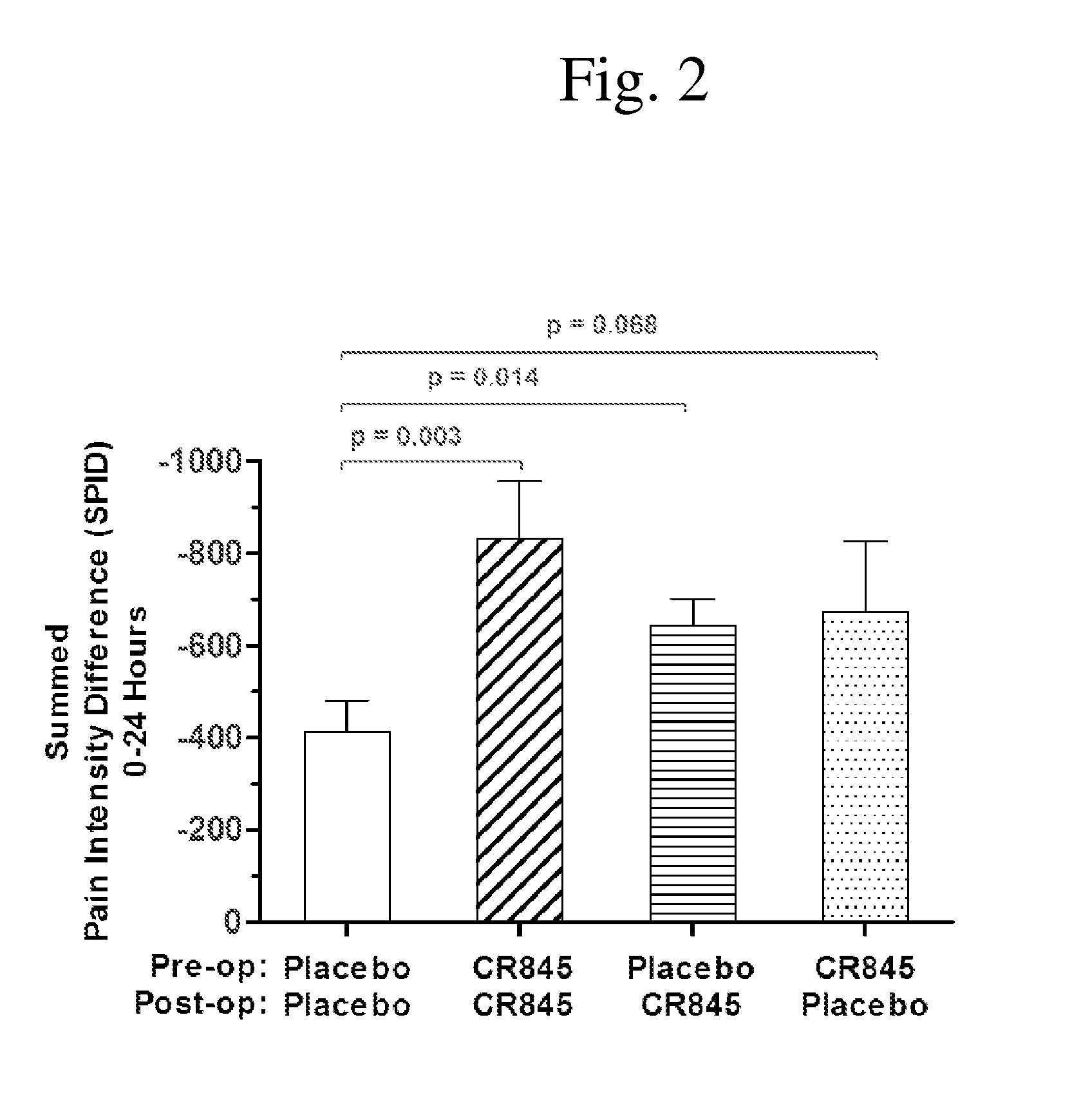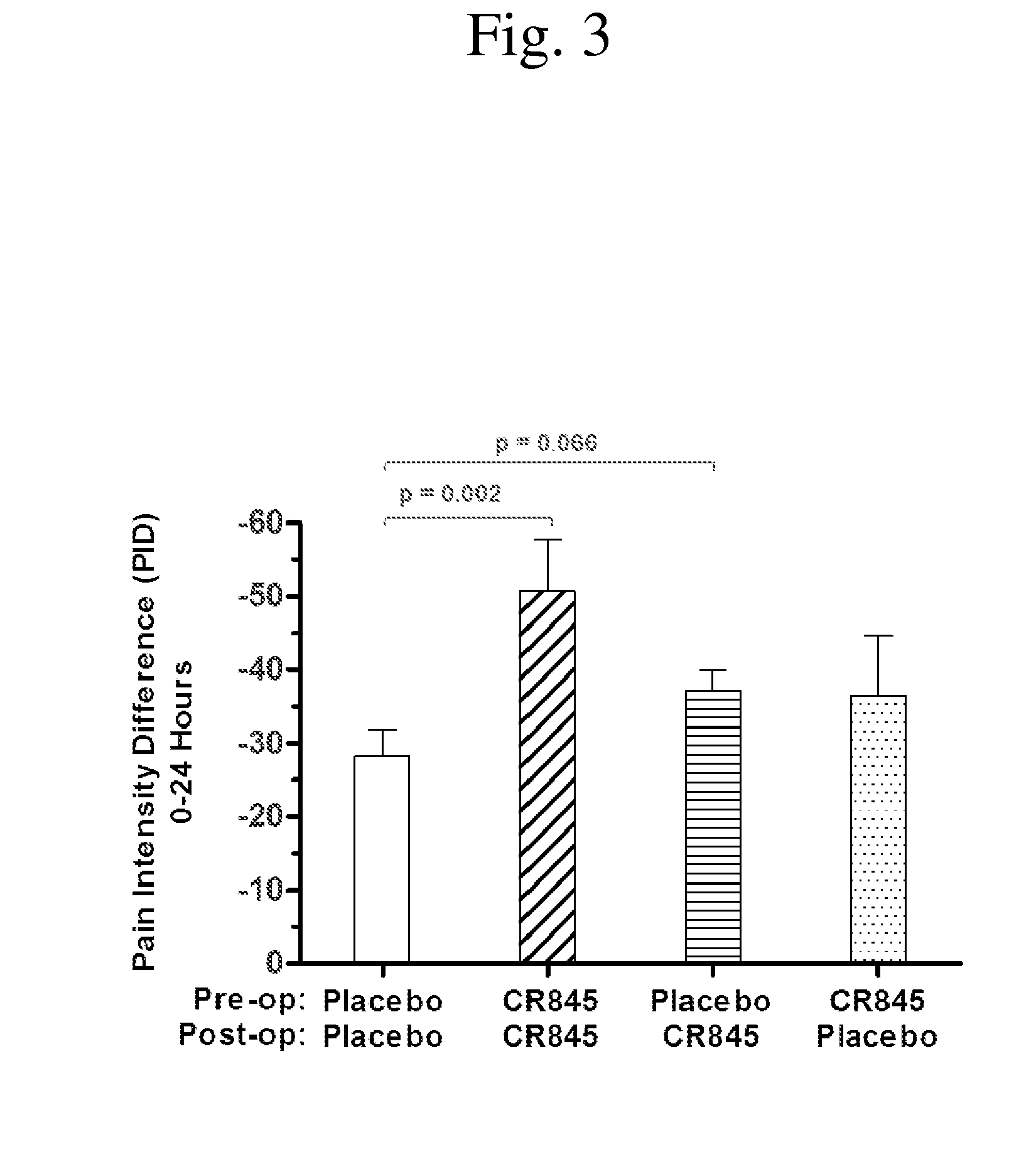Peripheral kappa receptor agonists for reducing pain and inflammation
a kappa receptor and agonist technology, applied in the field of prevention, inhibition or treatment of inflammation, can solve the problems of unwanted side effects of nsaids (e.g. ibuprofen), and achieve the effect of reducing patient need for morphin
- Summary
- Abstract
- Description
- Claims
- Application Information
AI Technical Summary
Benefits of technology
Problems solved by technology
Method used
Image
Examples
example 1
First in Man Clinical Trial of a Peripherally-Restricted Non-Narcotic Kappa Receptor Agonist
[0092]This trial was a phase 2 multi-center, double-randomized, double-blind, placebo-controlled study was conducted to evaluate the analgesic efficacy and safety of intravenous CR845 dosed preoperatively and postoperatively in patients undergoing a laparoscopic hysterectomy. The trial was conducted under an investigational new drug application (IND) filed with the US Food and Drug Administration (FDA).
[0093]This phase 2 trial multi-center, double-randomized, double-blind, placebo-controlled study was conducted in 22 sites in the United States. All clinical procedures were approved by the relevant Institutional Review Board (IRB) in compliance with the applicable laws and regulations of the US. The study was initiated up to fourteen (14) days preoperatively and the in-hospital period was approximately twenty-four (24) hours for each patient and follow up was conducted within seven (7) days of...
example 2
Relative Levels of Reduction of Post-Operative Pain (PIDs)
[0099]FIG. 3 shows the relative levels of reduction of post-operative pain over the first 24 hours after surgery as demonstrated by the pain intensity difference (PID) at each time point. As shown above for the summed pain intensity difference, patients receiving only placebo showed the least pain reduction and those receiving CR845 both before and after surgery showed the greatest reduction in the SPID pain score (twice the reduction over 24 hours as experienced by the patients receiving only placebo). Patients receiving one dose of CR845, whether before or after surgery exhibited an intermediate level of reduction in pain PID scores (i.e. more relief than seen in patients receiving only placebo, but less than the relief experienced by those patients receiving CR845 before surgery and also after surgery).
example 3
Morphine Self-Administered by the Patients
[0100]FIG. 4 shows the amounts of morphine (in milligrams) self administered by the patients in each group: placebo-placebo, placebo-CR845, CR845-placebo, and CR845-CR845 in the interval 2-4 hours, 4-12 hours and 12-24 hours post surgery. Patients receiving only placebo self-administered the most intrathecally delivered morphine (mITT), more than doubling the dose self administered from 2-4 hours during each of the 4-12 hour and 12-24 hour periods. By contrast, those patients receiving two doses of CR845 self-administered the least morphine in each time period.
Example 4
Evaluations of Pain Relief Assessed by Patients
[0101]FIG. 5 shows the evaluations of pain relief as assessed by the patients themselves. The four patient groups are those receiving pre- and post-operatively respectively:[0102](a) Placebo-Placebo;[0103](b) CR845-CR845;[0104](c) Placebo-CR845; and[0105](d) CR845-Placebo.
[0106]The Placebo-Placebo group (i.e receiving inactive pla...
PUM
| Property | Measurement | Unit |
|---|---|---|
| Structure | aaaaa | aaaaa |
Abstract
Description
Claims
Application Information
 Login to View More
Login to View More - R&D
- Intellectual Property
- Life Sciences
- Materials
- Tech Scout
- Unparalleled Data Quality
- Higher Quality Content
- 60% Fewer Hallucinations
Browse by: Latest US Patents, China's latest patents, Technical Efficacy Thesaurus, Application Domain, Technology Topic, Popular Technical Reports.
© 2025 PatSnap. All rights reserved.Legal|Privacy policy|Modern Slavery Act Transparency Statement|Sitemap|About US| Contact US: help@patsnap.com



